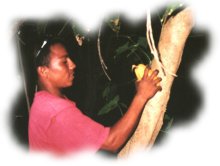
byCaroline Leanne WilsonSummer, 1999 |
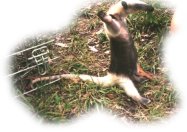
“ Internships in Sociology and Environmental Science”

|
|
 |
Belize is one of the most diverse countries in the Americas. This small country represents the southern most tip of the North American continental plate and its history is one of invasion, servitude, and exploitation coupled with recent political freedom. A growing sense of pride in its past and a feeling of encouragement about its future is allowing Belize to recover much of the country’s natural beauty and to improve the lives of its mixed racial and ethnic populations of people. |
|
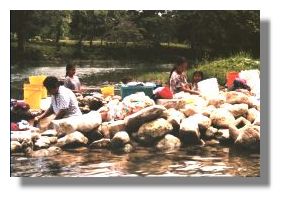 |
Belize has an interesting and somewhat disruptive history. Ancient Mayans built elaborate structures in the mountains and along its rivers. British pirates found safe haven within its long barrier reef. The country became British Honduras in 1793 after the British defeated the Spanish in the Battle of St. George’s Caye. |
Neither the Spanish nor the British were able to tame the Mayans so the British turned to slaves from Africa, indentured laborers from India, and Caribs from distant Caribbean islands. Creoles, descendents of African slaves, make up 60% of the population. They can range in skin tone depending on the mix of European ancestry. Mestizos are Spanish speaking Belizians of Spanish and Mayan descent. A mix of Africans and Carib Indians created the group known as Garifuna. There are three groups of Mayans and a few Mennonites communities. In 1981 the country became independent and its name was changed to Belize. |
|
I learned about Belize’s cultures and natural environment while conducting internships in sociology and biology for Carson-Newman College during the summer of 1999. The recent emphasis on ecotourism in Belize facilitated my study of the people and natural heritage of this interesting and deserving country. |
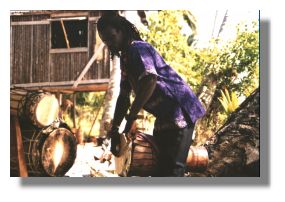 |
Belize has a variety of rich ecosystems ranging from mountains, to savannas, pine ridges, seasonal wet evergreen forests, rivers, and the world’s second largest coral reef. During the colonial period, most of the country’s logwood trees were harvested for purple dye. Mahogany trees were removed in great numbers and the country was exploited for its natural resources. |
|
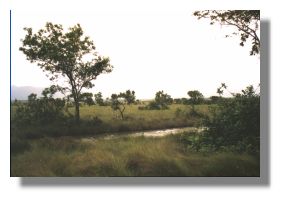 |
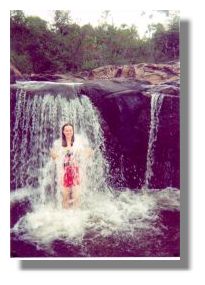 |
The watershed systems of Belize go through several habitat changes from mountaintops to the sea. Many rivers begin in the Pine Ridge region of the Mayan Mountains. The Rio On River flows over rocks forming waterfalls and large pools. Atop a mountain in a far off area is the Mayan ruin called Caracol, which contains the tallest building in the entire country. I think this site is the most impressive and breathtaking ruin in Belize because it is a massive, basically unexcavated city hidden by the jungle. There are numerous living cave systems in Belize. Eroded limestone and acidic water form a biological soup causing caves and sink holes. Underground rivers flow through caves that can sometimes be accessed by people. These caves often harbor some exotic fauna.  I had the privilege of participating in a six-hour tube float through the River of Caves. Three Mayan guides lead us through the pitch-black caves and we had only headlamps to light our way. We saw sunshine in a few spectacular openings in the cave revealing the dense canopy of the jungle. The earth in the caves is saturated and porous making it easy to have large active stalactites, stalagmites, and columns. Some caves still contain large ancient Mayan pots that were used to collect sacred water.
Northern and Central Belize are composed of open savannas and meandering rivers. I spent most of my time in this area at Monkey Bay Wildlife Sanctuary. Matthew Miller is director of this 1,070 acre natural area that contains two miles of the Sibun River shoreline. At Monkey Bay, we camped under thatched platforms called palapas. Electricity was solar powered and rainwater was captured in huge vats for drinking. People in rural areas bathe and do their laundry in rivers. The latrine was a biogas generator where the waste produced was converted into methane gas and then used for fuel in the kitchen. Meals at Monkey Bay were mainly vegetarian. While at Monkey Bay, I worked in the small raised bed tree nursery and helped out with visiting college groups.  Mangroves line the Belize coast and the mouths of rivers. Mangroves are home to many forms of wildlife including marine animals, American crocodiles, and manatee. Past the mangrove swamps lies the Caribbean Sea which contains the second largest barrier reef in the world. I swam with dolphins, stingrays, nurse sharks, barracuda, and hundreds of different species of coral and other reef life. Many people fish for lobster, conch, and snapper. There are three endangered species of sea turtles native to Belize. I became acquainted with Leroy Andrewin, a Creole of Gales Point Manatee, who is continuing to protect the hawksbill, green, and loggerhead turtles. At the time of my study, six nests had been found and protected. The sea turtle project has been denied funding by the Belize Fisheries Department this nesting season so the only workers are Mr. Andrewin and one volunteer.  Four hundred and fifty islands and three atolls exist off the shores of Belize. I traveled an hour and a half southeast of Placencia Town with a college group from Texas to a very small island called Renguana Caye. This caye is only inhabited by the care taker, his wife, and dog. On the first night, the gusty wind blew my tent into the ocean and the pelicans used it for a roost. Sleeping in a wet stinking tent didn’t alter my impression of the beauty of this sandy palm tree island surrounded by coral reef. We caught our food and snorkeled over a two day period. Renguana Caye met my expectations of paradise.  On land, the coastal beach of Placencia is also picturesque. I had the coconut trees and hammocks basically to myself along the beach only to be shared with the occasional Rastafarian walking by and a few travelers. Belize is composed of seasonal wet evergreen forests that cover the Mayan Mountains creating a completely different environment from the northern half of the country. I experienced three adventurous weeks in the Bladen Nature Reserve. After a treacherous, muddy, six-mile trek alone in the bush during the heat of the day with a sixty-pound backpack, I finally arrived at the Bladen River. I canoed across the river with two Ketchi Mayans and soon located the remote camp. This was the permanent home of Jake Marlin, a herpetologist, and Kelly Marlin who does animal rehabilitation and reintroduction into the wild. They have a four year old daughter, Sophia, and a one year old son. 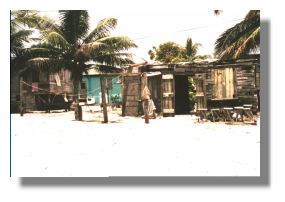 The first week I spent clothed from head to toe working one-on-one with Will Jones. Will is an extremely intriguing person that has decided to live in the jungle and learn how to establish and maintain a permaculture garden. The first thing I learned was how to sharpen and use a machete. Will taught me the techniques he uses to grow the local spices, fruits, and vegetables. Planting a pineapple orchard was our next task. I planted over seventy spinney pineapple plants, thirteen mahogany trees, and three anona trees. |
|
 |
The rest of my stay I spent exploring the preserve with my machete and looking for animals. I saw howler and spider monkeys as well as boa constrictors, coral snakes, fer-de-lances, Morelet’s crocodiles, kinkajous, scorpions, parrots, toucans, the rare Agamy heron, and many other animals and birds. |
I tramped around in ponds and canoed a crocodile infested lagoon at night with David Drovillar, a researcher doing a regional frog survey. The bush at night is a land all its own with sounds and creatures all around. I ran into a close call at night when the most deadly snake in the world crossed my path. A five-foot long fer-de-lance struck at the girl in front of me and then came in my direction. A bite by this extremely venomous viper would have meant death. |
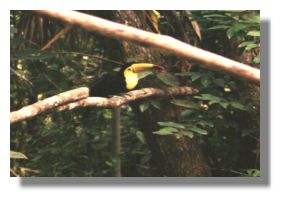 |
| While at BFREE, Bladen Foundation for Research and Environmental Education, I dealt with many blood sucking and parasitic insects including the botless fly that leaves blood spots on the surface of the skin, doctor flies, and many mosquitoes. The most noted pest was probably the human skin bot fly that deposits its eggs on the sides of bloodsucking flies and mosquitoes. While the mosquito is feeding, the eggs are deposited on the host. The bot fly larva hatches from the egg and penetrates the host’s skin. This parasite, locally called a beefworm, grows under the skin while eating fatty tissues. In about ten days the infected person can sense the larva as it feels like someone piercing your skin with a needle and twisting it. |
|
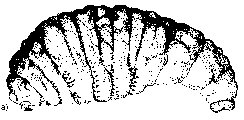 |
I had four of these sweet little blood sucking parasitic insects under my skin and can testify that as the beefworm grows the pain becomes more intense. Two of my bot fly larvae were removed by poisoning the maggot with tobacco juice and suffocating the larvae with duct tape over the air hole. The larvae are then squeezed out. I actually arrived back home with a bot fly larva under my scalp. I named her Lilly and eventually had her removed by a physician. Bugs or not, my experience at BFREE is one that I have always dreamed of and would never take back. |

My summer in Belize presented some hard and occasionally lonely and dangerous times. I ate, slept, drank, and played right along with the Belizians in many occasions where I was the only gringa. I met amazing people and established great friendships that truly impacted my life. I will never forget them. A new world was opened in my understanding of my own culture, and I obtained a glimpse of another life far different than mine. |
|
ACKNOWLEDGMENTS I appreciate everything that my mother and father did in supporting this trip. Thank you for understanding my hunger for adventure, your patience, persistence in finding the perfect place for my internship, and the financial and mental backing that allowed it to happen. I thank Matthew Miller, his wife Marga, and daughter Rochelle for their wonderful cooperation and open welcome at Monkey Bay. Thank you Matt for being my teacher. Special thanks to Maureen Fox, Fernando Galvez and the entire Guerra family in Orange Walk and Benque for being caring friends over the entire summer. I also express a grand thanks to Dr. Mary Ball and Dr. Ray Dalton at Carson-Newman College for guiding me in my internships. Thanks to all of my friends who wrote me many letters during my stay in Belize. I appreciate Judson College allowing me to publish this article on the Webspinner. Images and HTML coding with HoTMetaL Pro 5.0 by Caroline L. Wilson. |
|